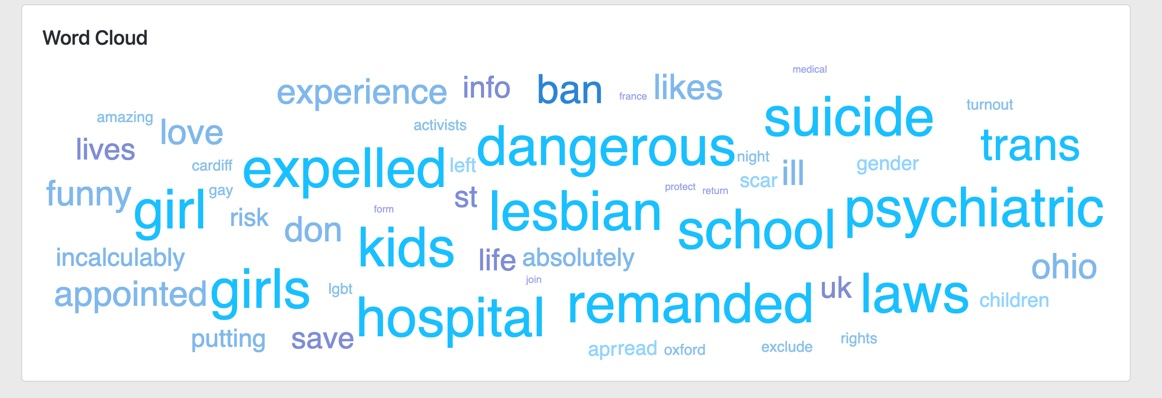Queer Displacement Digital Resource Center
There is a long history of forced dislocation of the LGBTQ community. As opposed to the large-scale events that often precipitate displacement, the nature of queer displacement is quiet and often individualized, ultimately rooted in the pathologization of queer identities. The resource center seeks to compile the conditions that lead to queer displacement and provide a library for scholars and members of the community. The resource center includes research articles, visualizations, and where to find more information. See the About section for details of the research questions and conclusions.
Research
Map
This interactive map provides a visual context for how these events are distributed across the world. Click on each marker to learn more. Source: https://www.google.com/maps/d/u/0/edit?mid=1yn4a4IDdOF3y9G-9smLga7quZILEzKFP&usp=sharingLinks to an external site.
Text Analysis

In this text analysis, we created a word cloud from tweets tagged "ConversionTherapy". It gives us an insight into the conversation about the topic. The law and bans, regions that are facing upcoming changes, and outcomes of conversion therapy all play a large part in the conversation. Created with https://www.vicinitas.io/

In this text analysis, we created a word cloud from tweets tagged "Queer Refugees". It gives us an insight into the conversation about the topic. Like the conversion analysis, we see the locations affected by queer displacement currently, as well as some of the concerns surrounding it. Created with https://www.vicinitas.io/
About the Project
The Queer Displacement Digital Resource Center is a research project by MLIS candidate and researcher Amelia Muzzarelli. All suggestions, thoughts, and leads on further research are welcome! Contact the author at amuzzarelli@my.dom.edu
Research Questions and Conclusions
Question 1: How widespread is queer displacement?
Conclusion: In indexing the data gathered from research and mapping it, it is clear that queer displacement is not limited to one locality or even one continent. There are instances to be found throughout history all over the world. See the map under Visualizations for more information.
Question 2: Is queer displacement a uniquely historical event?
Conclusion: The volume of recent news reports and developing stories of new anti-LGBTQ legislation indicate that this issue is definitely widespread in the modern era. See research articles "Modern Legislation" and "Conversion Efforts" for more information.
Question 3: What are the topics of conversation about the modern instances of queer displacement?
Conclusion: Based upon the sentiment analyses done of recent Twitter discourse, those discussing these issues are most concerned about the effects of conversion therapy on children and what is currently being enshrined in law. Rwanda and the UK are currently topics of conversation due to recent violence and legislation targeting LGBTQ individuals. See Text Analysis under Visualizations for more information.
References and Further Reading:
Clark, Tom Campbell, and Supreme Court Of The United States. U.S. Reports: Boutilier v. Immigration Service, 387 U.S. 118. 1966.
Dickinson, Tommy. ’Curing Queers’ : Mental Nurses and Their Patients, 1935-74 (Manchester: Manchester University Press, 2015)
Drescher, Jack, Alan Schwartz, Flávio Casoy, Christopher A. McIntosh, Brian Hurley, Kenneth Ashley, Mary Barber, David Goldenberg, Sarah E. Herbert, Lorraine E. Lothwell, Marlin R. Mattson, Scot G. McAfee, Jack Pula, Vernon Rosario, and D. Andrew Tompkins “The Growing Regulation of Conversion Therapy,” Journal of Medical Regulation, 102 no.2 (2016): 7–12.
Farley, Harry, and Eleanor Lawrie. “What is conversion therapy and when will it be banned?” BBC News. (May 11, 2022). https://www.bbc.com/news/explainers-56496423.
Gallagher, Sophie, and Josh Parry. “Conversion therapy: Ban to go ahead but not cover trans people.” BBC News. (April 1, 2022). https://www.bbc.com/news/uk-60947028
Halkitis, Perry N. The AIDS Generation : Stories of Survival and Resilience. (Oxford: Oxford University Press, 2014).
“The Cost of Coming Out: LGBT Youth Homelessness.” (Cambridge: Lesley University School of Human Services, n.d.)
Lautmann, R. “The pink triangle. The persecution of homosexual males in concentration camps in Nazi Germany.” Journal of homosexuality vol. 6,1-2 (1980): 141-60.
Lavietes, Matt, Elliott Ramos. “Nearly 240 anti-LGBTQ bills filed in 2022 so far, most of them targeting trans people.” NBC News. (March 20, 2022). https://www.nbcnews.com/nbc-out/out-politics-and-policy/nearly-240-anti-lgbtq-bills-filed-2022-far-targeting-trans-people-rcna20418.
Mallon, Gary. “Gay and No Place to Go: Assessing the Needs of Gay and Lesbian Adolescents in Out-of-Home Care Settings.” Child Welfare 71, no. 6 (November 1992): 547–56.
Mallory, Christy, Taylor N.T. Brown, and Kerith J. Conron. "Conversion Therapy and LGBT Youth Update." ULCA School of Law Williams Institute. (June 2019). https://williamsinstitute.law.ucla.edu/wp-content/uploads/Conversion-Therapy-Update-Jun-2019.pdf.
Movement Advancement Project. "Equality Maps: Conversion Therapy Laws." https://www.lgbtmap.org/equality-maps/conversion_therapy.
Smith, Glenn, Annie Bartlett, Michael King, “Treatments of homosexuality in Britain since the 1950s--an oral history: the experience of patients.” BMJ Clinical research ed. vol. 328,7437 (2004): 427.
Stein, Marc. “All the Immigrants Are Straight, All the Homosexuals Are Citizens, But Some of Us Are Queer Aliens: Genealogies of Legal Strategy in Boutilier v. INS.” Journal of American Ethnic History 29 no.4 (2010): 45–77.
Human Rights Watch. #OUTLAWED: “The love that dare not speak its name” https://features.hrw.org/features/features/lgbt_laws